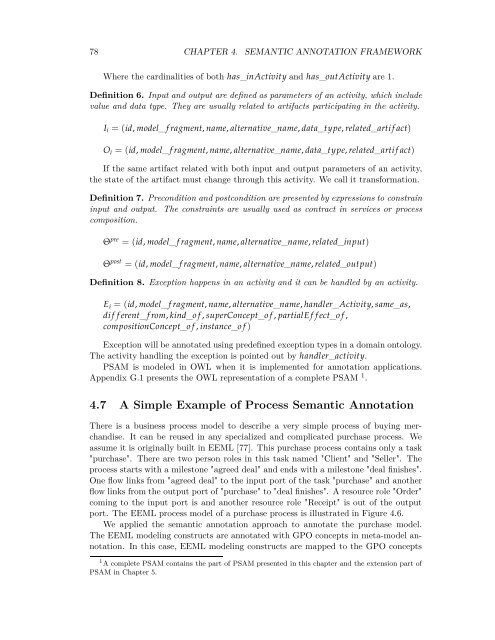Semantic Annotation for Process Models: - Department of Computer ...
Semantic Annotation for Process Models: - Department of Computer ...
Semantic Annotation for Process Models: - Department of Computer ...
You also want an ePaper? Increase the reach of your titles
YUMPU automatically turns print PDFs into web optimized ePapers that Google loves.
78 CHAPTER 4. SEMANTIC ANNOTATION FRAMEWORK<br />
Where the cardinalities <strong>of</strong> both has_inActivity and has_outActivity are 1.<br />
Definition 6. Input and output are defined as parameters <strong>of</strong> an activity, which include<br />
value and data type. They are usually related to artifacts participating in the activity.<br />
I i = (id, model_f ragment, name, alternative_name, data_type, related_arti f act)<br />
O i = (id, model_f ragment, name, alternative_name, data_type, related_arti f act)<br />
If the same artifact related with both input and output parameters <strong>of</strong> an activity,<br />
the state <strong>of</strong> the artifact must change through this activity. We call it trans<strong>for</strong>mation.<br />
Definition 7. Precondition and postcondition are presented by expressions to constrain<br />
input and output. The constraints are usually used as contract in services or process<br />
composition.<br />
Θ pre = (id, model_f ragment, name, alternative_name, related_input)<br />
Θ post = (id, model_f ragment, name, alternative_name, related_output)<br />
Definition 8. Exception happens in an activity and it can be handled by an activity.<br />
E i = (id, model_f ragment, name, alternative_name, handler_Activity, same_as,<br />
di f f erent_f rom, kind_o f , superConcept_o f , partialE f f ect_o f ,<br />
compositionConcept_o f , instance_o f )<br />
Exception will be annotated using predefined exception types in a domain ontology.<br />
The activity handling the exception is pointed out by handler_activity.<br />
PSAM is modeled in OWL when it is implemented <strong>for</strong> annotation applications.<br />
Appendix G.1 presents the OWL representation <strong>of</strong> a complete PSAM 1 .<br />
4.7 A Simple Example <strong>of</strong> <strong>Process</strong> <strong>Semantic</strong> <strong>Annotation</strong><br />
There is a business process model to describe a very simple process <strong>of</strong> buying merchandise.<br />
It can be reused in any specialized and complicated purchase process. We<br />
assume it is originally built in EEML [77]. This purchase process contains only a task<br />
"purchase". There are two person roles in this task named "Client" and "Seller". The<br />
process starts with a milestone "agreed deal" and ends with a milestone "deal finishes".<br />
One flow links from "agreed deal" to the input port <strong>of</strong> the task "purchase" and another<br />
flow links from the output port <strong>of</strong> "purchase" to "deal finishes". A resource role "Order"<br />
coming to the input port is and another resource role "Receipt" is out <strong>of</strong> the output<br />
port. The EEML process model <strong>of</strong> a purchase process is illustrated in Figure 4.6.<br />
We applied the semantic annotation approach to annotate the purchase model.<br />
The EEML modeling constructs are annotated with GPO concepts in meta-model annotation.<br />
In this case, EEML modeling constructs are mapped to the GPO concepts<br />
1 A complete PSAM contains the part <strong>of</strong> PSAM presented in this chapter and the extension part <strong>of</strong><br />
PSAM in Chapter 5.
















